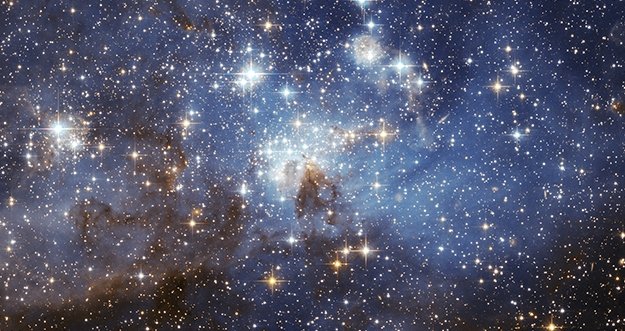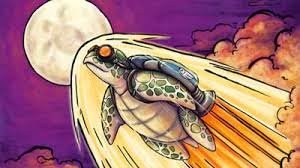Astronomical Facts about the Sun, Moon, Stars & Planet
Regards Steemians !!
Astronomy is the study of celestial bodies such as stars, comets, planets, and galaxies.
Astronomy comes from the Greek words 'astron' and 'nomos' which means 'star' and 'law'.
This science is concerned with the formation and development of the universe, the motion of celestial bodies, as well as the evolution of the physics and chemistry of celestial bodies.
Since the 20th century, the field of astronomy has been divided into two branches: observation and theoretical.
Astronomical observations emphasize the collection and analysis of data using the basic principles of physics.
Theoretical astronomy focuses on the analysis and development of computer models to explain astronomical objects and phenomena.
1. Interesting Facts about the Sun.
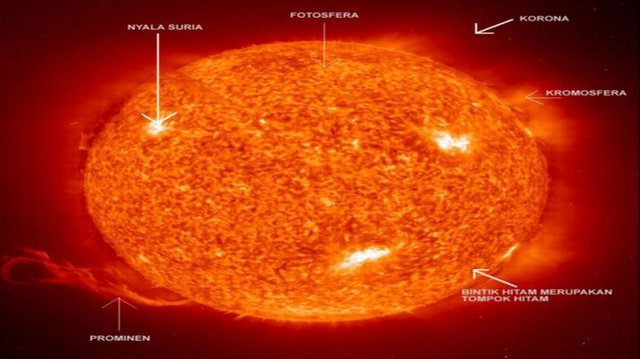
Image Source
The Sun has been around 4.5 billion years old and generated 383 billion trillion kilowatts of energy
If all the hydrogen in the Sun has burned out, then the sun takes 130 million more years to burn helium. With the burning and radiant rays so strong, the temperature of the sun can reach about 15 million degrees Celsius.
Sunlight takes 8 minutes to reach the earth and is responsible for the dynamics of ocean currents and weather patterns on earth.
The Earth orbits the sun in an elliptical orbit, making the distance between the earth and the sun vary within a year.
The size of the sun is actually just average compared to other stars, but still accounts for 98% of the total material in our solar system.
The solar wind can reach a distance of up to 50AU. One AU is equivalent to the distance from earth to the sun.
Lightning that occurs in the sky has a temperature almost 3 times hotter than the sun.
The sun can explode like a giant bomb, lo. But you do not worry, because the Sun will not explode without cause. Explosion will occur when the gravitational power it has lost. The gravity of the sun itself is about 28 times larger than the Earth's gravity.
At the time of orbiting the galactic nucleus, 1 day in the Sun is tantamount to 25 to 38 days on Earth. When orbiting it, the Sun moves at a speed of 220 km / sec.
Scientists who first say that the Earth and other planets revolve around the Sun, is Aristarchus. He lived in 310 - 230 BC, more than two thousand years ago. But the reality of the theory was never trusted by the public, lo. Later, the British scientist, Isaac Newton (1642 - 1727), returned to provide evidence. Actually all planets orbit around the Sun (not the Sun that surrounds the Earth and the surrounding planets). Only then did the theory finally be accepted.
If a man on earth weighs 70 kg, when he stands on the surface of the Sun, his weight will change 28-fold, lo. The alias becomes 1,960 kg.
The Sun is considered a number of civilizations as a God, one of which is the Aztec Tribe in Mexico. Some people in countries that get the title of sunrise, Japan, also think the same as the Aztecs.
Ulysses is the spacecraft that first studied the sun. Ulysses was carried by the Discovery plane, then launched onto Jupiter planet with a booster rocket. After studying Jupiter for 17 days, Ulysses uses the gravity of the giant planet (Sun) to throw it into the orbit of the ecliptic, the sphere of the line that becomes the path of the heavenly bodies in the solar system.
2. Interesting Facts about the Moon
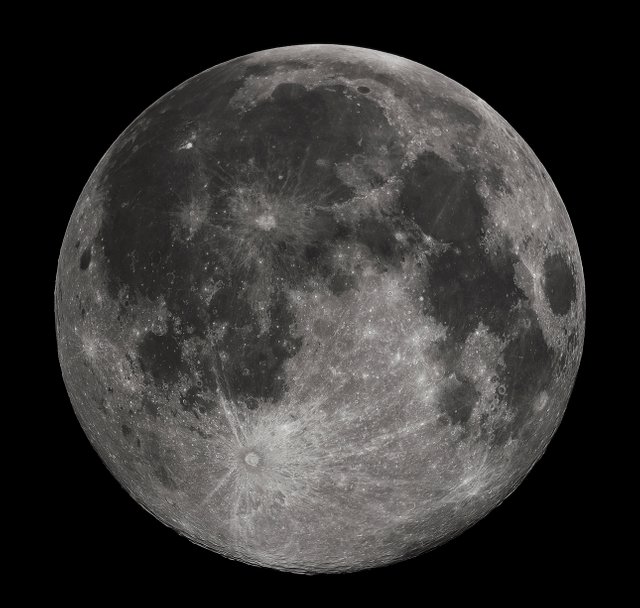
Image Source
The moon is the only celestial body in which humans once walked on it.
Scientist. Eugene Shoemaker loves the moon very much. After his death, his ashes were spread to the moon by the Lunar Prospector spacecraft in 1999.
The footprints left by astronaut Neil Armstrong is the first trace of man on the moon.
Every year the moon moves away from the earth about 3 cm.
people used to theorize that the moon was part of the earth that flies out of the earth because of a great impact in the past. And this is almost a theory approved by many people. Previously other theories emerged as formed from the dust of space that forms into the Earth's satellites.
Lately the theory says that if parts of the moon are drawn from the earth, then the earth will not be round as it is now. And if the moon is not hollow, then it is unlikely that the moon could become a satellite of the earth, because it is too heavy and the moon will hit the earth.
- It turns out that the turtle is the first time around the moon, not a human or monkey first sent to orbit around the moon. Rather it is a pair of tortoises. The tortoise is flown to the moon with beetles, a kind of fly, seeds, and bacteria inside the Russian spacecraft, Zond 5 in September 1968. This turtle can return safely with his plane to earth, although the tortoise experienced a weight loss of about 10 percent of their body weight. However, they remain in healthy condition.
7.Orbit of the moon is the only one that is really almost perfectly round from all our solar system. The main weight of the moon is closer to 6000 feet than its geometrical center, which should in fact lead to a curved orbit.
Something unknown has kept the moon stable on its axis. A theory that is not yet believed to be true also says that the face of the moon is always the same in every day because of something that causes it. In essence, it remains an astronomical coincidence.
Normally a planet will be hard inside and gradually more gentle on top, like our earth. No such thing with the moon. The inside of the moon is like a hollow, while the top is hard as hard as Titanium. This is what causes the moon is very strong and resistant to attack.
The largest crater in the moon has a diameter of 300 Km, with a depth of only 6.4 Km. Meanwhile, according to scientists, if the rocks that hit the moon before, hit the earth, it will form a hole at least as deep as 1200 KM.
The hollow moon is also evident when the Apollo crew leaves the moon, throwing back the rest of the unused plane back to the moon.
As a result, an earthquake and echoes on the lunar surface occurred for 15 minutes. This discovery was repeated again by Apollo 13 crew, who this time fell harder, causing an echo for 3 hours 20 minutes.
It was like the sound of a bell that then chimed, only because there is no air, then the sound of the bell chimes produced can not be heard by humans. Meanwhile, this discovery was questioned by Carl Sagan, that natural satellites could not be hollow in it.Extreme weather is not unusual. The moon's surface temperatures can range from 260 Celsius to -151 Celsius. However, the temperature was only on the surface of the moon alone. If you dig the surface of the moon, then the temperature is quite constant which is about -35 Celsius.
The moon can cover the sun in a total lunar eclipse, but its size is not the same. Interestingly, the distance of the sun to Earth is exactly 395 times the distance of the moon to the earth, whereas the solar diameter is exactly 395 times the diameter of the moon.
At the time of the total solar eclipse, the size of the earth and the moon are exactly the same, so the sun can be completely covered in the moon. This count is too thorough and accurate if it is just a mere astronomical coincidence.Age of the moon is older than expected, even thought to be older than the earth and the sun itself! The oldest estimated age of the earth is 4.6 billion years.
Meanwhile, the moon rocks are already 5.3 billion years old. Month is 1 billion years older than earth!
3. Interesting Facts About Stars
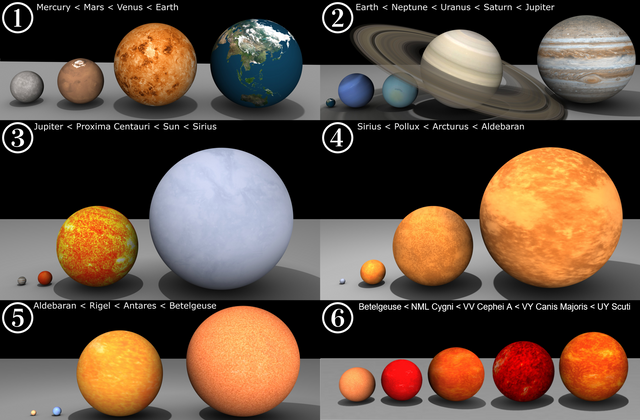
Image Source
- There are almost 1 × 10^22 stars in the universe.
- Some of the stars are so distant from Earth that the light must travel millions of years before it reaches the earth.
- Proxima Centauri is the closest star to our solar system and is about 4 light-years away.
- In the nebula, when the gas and dust begin to solid, a new object is formed which is known as protostar (forerunner of the star).
- Depending on the surface temperature, star colors vary from red, orange, yellow, white, to blue.
- A supernova explosion destroys a star as a whole.
- Pulsar, a neutron star discovered in 1967 radiated radio waves.
- Polaris or northern stars are the only stars in the sky that do not seem to move from night to night.
- stars provide white light. However, the facts prove that not all stars are white. Colder stars are slightly reddish / orange. Hot stars are whitish blue. The sun is a yellow star giving medium-sized heat.
- All stars have different sizes to each other. There are some stars that can accommodate millions of sun that means big. There is also a smaller than the moon.
- Have you seen and noticed there are stars that are close together? As if they were like a couple. This is due to the force of gravity or a tensile force, the previously separated star united by the force of gravity. That's why some stars are paired.
- A star scientist, looking through the Hubble space telescope. He found that there was a great star, Betelgeuse. This giant super star has a diameter of 700 times the diameter of the sun. Waaw, imagine how big a Betelgeuse star.
- Scientists believe that, some of the stars in the sky appear to be wobbling which is caused by the tensile forces of orbiting planets. Orbit is the path through which the planets travel around.
4. Interesting Facts about the Planet
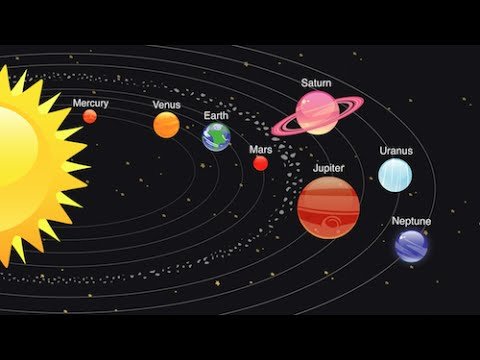
Image Source
Mercury is the second smallest planet in the solar system and has no moon.
Maximum temperatures Mercury can reach 800ºC with a minimum temperature of 300ºC below zero.
One year in Mercury equals 88 days on earth. Mercury is taken from the name of the Roman god of commerce.Venus is the only planet that rotates from east to west. A day on this planet equals 225 days on earth.
Earth and sun are about 93 million miles away. It takes about 16 million horsepower to break away from Earth's gravitational pull.
According to scientists, about 5 billion years longer days on earth will be 48 hours.
It was a time when the sun would explode after reaching its final phase of evolution.The planet Neptune was discovered more than 150 years ago in 1846.
From that time on, Neptune still completes its orbit around the sun. This planet requires 165 years to once orbit the sun.Pluto has no fixed orbit. Sometimes its orbit crosses Neptune's orbit.
The size of Pluto is so small that it makes scientists lower the pluto status of the planet into a dwarf planetVenus is the hottest planet in the solar system, although the distance of Venus is 30 million miles farther from the sun than Mercury's distance to the sun. So how could it be like that?
Simple. It's about the atmosphere. the atmosphere on a planet allows solar thermal energy to 'survive' on the planet. Well, the problem is that Mercury has no atmosphere.
While Venus has a very thick atmosphere. It is the atmosphere that keeps the sun's energy in the planet Venus. And make Venus has an average temperature of 468 ⁰C.In addition to being the largest planet, it turns out Jupiter also protects all other small planets. Like a Jupiter-sized magnet, it can pull anything onto Jupiter itself.
This is because Jupiter's gravity is very strong. Once upon a time there was a comet pointing toward the earth, the comet was discovered by Pierre-Simon Laplace. However, when it passes Jupiter, the comet changes direction. The direction of the comet moves towards JupiterApparently there are rocks on Earth that comes from Mars and not humans who brought it to earth. Analysis of meteorites in Antarctica, the Sahara desert, and several other places on Earth shows astonishing.
The stones are from Mars. The proof for example is that there is a gas that is identical to the gas in the atmosphere of Mars.Mount Olympus Mons named has a cross-sectional distance from one side to the other along 600 km, and has a height of 25 km is the highest mountain that there is arranged solar, which is located on the planet Mars
There are many more facts we never knew. You can explore it yourself with a browser engine, Google. Happy exploring!
best regard @alf4t1h
Reference :
- https://id.wikipedia.org/wiki/Astronomi
- https://www.nationalgeographic.com/science/space/solar-system/the-sun/
- http://www.dw.com/id/10-fakta-ajaib-tentang-matahari/g-18324686
- https://en.wikipedia.org/wiki/Moon
- https://astronesia.blogspot.co.id/2013/06/10-fakta-mengejutkan-tentang-bulan.html
- https://techno.okezone.com/read/2017/08/20/56/1759142/nih-8-fakta-mengejutkan-tentang-bulan-yang-belum-kamu-ketahui
- https://en.wikipedia.org/wiki/Star
- https://gurumurid.com/fakta-menarik-tentang-bintang/
- https://en.wikipedia.org/wiki/Planet
- http://www.infoastronomy.org/2017/03/5-fakta-menarik-tentang-tata-surya-kita.html

